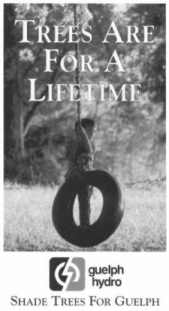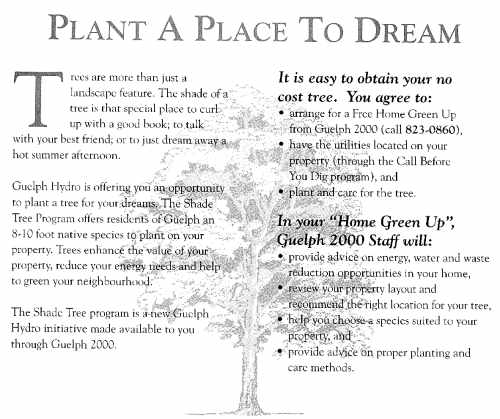Guelph 2000
Started in 1993 under Ontario's Green Communities Initiative, Guelph 2000 provided a home visit service that encouraged City of Guelph residents to undertake a wide variety of conservation related actions in their homes, including sustainable landscaping practices.
Background
Guelph 2000 began in 1993 as a pilot under the Green Communities Initiative. The home visit service it helped to develop became the standard used by other Ontario Green Communities (see the ReCAP case study).
After two years of operation, Guelph 2000 had undertaken over 2,100 home visits. It needed to develop new approaches that would appeal to a broader range of interests and attract more participants.
In 1995, two new programs were introduced to appeal to gardeners and promote resource efficient landscaping practices. A Shade Tree Program, made possible by a donation from Guelph Hydro, offered a free tree with every home visit. An annual garden tour was also developed to showcase the private gardens of residents who had already adopted sustainable gardening practices.
Delivering the Program
The Guelph home visit was similar to the other Green Community home visits described in this Workbook (see the ReCAP and The Environment Network Case Studies).
Arranging the Visits
Of the 1,400 home visits completed in 1995, 35 percent were generated through the Shade Tree Program. It attracted a disproportionately high number of bookings from people in newer homes. These homes were more energy efficient than many others, and therefore presented fewer opportunities for further improvement.
The second most effective promotional tool was word-of-mouth referral (Word-of-mouth), which generated 30 percent of the home visits. Telemarketing accounted for 10 percent.
The spring mailing conducted through brochure inserts in Guelph Hydro mailings generated a 1 percent response rate for home visit bookings; fall mailing generated a 0.6 percent response rate.
In an attempt to boost word-of-mouth promotion, Guelph 2000 organized a raffle for an $800 mountain bike. Home visit coupons were filled out by advisors during a home visit and left with the householder who could pass them out to family and friends. If these people then arranged a home visit, the advisor would collect the coupon, and enter the original householder in the draw.
Organizers found it difficult to track the success of this trial. While people reported that the coupons played a role in prompting their call, the coupons were often misplaced. In all, only about 80 coupons were collected.
Shade Tree Program
As an incentive to participate in Guelph 2000's home visit initiative, householders were offered a free tree for their property through the Shade Tree Program (Financial Incentives and Disincentives). The trees offered were at least 12 feet high, some as high as 21 feet. They therefore represented a significant offer.
The offer was linked to common motivators such as saving money, and enhancing comfort and lifestyle. These motivators were vividly communicated in promotional statements and images (Vivid, Personalized Communication).
The Shade Tree Program was promoted primarily through a brochure insert in Guelph Hydro mailings. In 1995, 60,000 brochures were mailed, half in the spring and half in the fall.
The program built motivation and commitment by involving the householder at every stage. During the home visit, householders could choose from a selection of five species of deciduous trees indigenous to the Guelph area. A colour portfolio illustrated the trees at maturity, with information on height, shape of canopy, and types of seeds or fruit. Advisors went with the householder to view the yard to help select a tree and a planting site. Characteristics of the different trees were linked to the householder's preferences and yard conditions. Householders were responsible for planting the tree or hiring a contractor. The site was marked with a stake painted green with the Guelph 2000 name on it, to attract the attention of neighbours (Building Motivation Over Time and (Norm Appeals).
Alternative Garden Tours
Guelph 2000 hosted an annual self-guided garden tour that showcased resource-efficient gardens. The tour provided an opportunity to communicate vividly to Guelph residents the benefits of such landscapes (Vivid, Personalized Communication) and to show others gardening sustainably (Norm Appeals). According to Evan Ferrari, Manager of Guelph 2000, "Many tour participants remarked that they had thought about trying alternative gardening techniques, but had previously hesitated because they had never seen it done by others in their community."
The event was publicized primarily through media coverage, both before and after the event, and by some paid advertising. Participants paid a $5 registration fee and were provided with a tour map. The gardens demonstrated such features as the use of non-synthetic fertilizers, non-chemical pest control methods, use of indigenous plants, planting windbreaks and shade trees, and growing vegetable and herb gardens.
A printed guide highlighted common motivators such as lower maintenance and improved aesthetics and privacy. In the 1995 guide, one garden was described as being a "tranquil, shade-filled retreat," another as providing "a residential oasis ... without the need for pesticides," while yet another had "bold but easy to care for perennials."
Each garden had a host on hand to answer questions from tour participants (Vivid, Personalized Communication). Hosts were either the householders, or volunteer landscape architect students.
Financing the Program
Guelph Hydro was interested in reducing peak electrical demand during the air conditioning season and had an existing tree planting budget to replace trees removed to provide utility access.
In 1995, it committed to donating up to 1,200 trees at an estimated value of $20,000, as well as $50,000 in administrative support. The 600 trees that were actually ordered by residents represented a value of $10,000.
$300 was spent in advertising the Alternative Garden Tour.
Administrative costs for the Shade Tree and Alternative Garden Tour Programs are not known.
Results
Over a three-year period, Guelph 2000 undertook over 3,300 home visits and generated the following results among participating households:
- 25 percent began to practise alternatives to avoid generating household hazardous wastes
- 65 percent performed a major energy saving measure such as replacing windows, adding insulation, or replacing the furnace
- over 50 percent undertook air sealing activities
The Shade Tree Program generated the following results in 1995:
- 600 trees
- sign-ups for 489 home visits, prompting local conservation-related upgrades or renovations valued at approximately $1.3 million
A follow-up survey showed that tree survival was somewhat higher for contractor plantings. The overall survival rate was 85 percent.
The 1995 Alternative Garden Tour, featuring 16 gardens, achieved these results:
- 200 residents participated in the tour
- 15 home visits were generated, prompting local conservation-related upgrades or renovations valued at about $42,000.
Contacts
This program stopped running in 1996, and the Guelph 2000 office was closed.
Notes
Guelph 2000 is one of a number of Green Community case studies on this site. The others are The Environment Network, ReCAP and Peterborough Green-Up. For more information on Green Communities click here.
Additional key words: pollution prevention
This case study was originally published in 1998 in "Tools of Change: Proven Methods for Promoting Environmental Citizneship" by Jay Kassirer and Doug McKenzie-Mohr (Published by Canada's National Round Table on the Environment and the Economy)
Search the Case Studies


